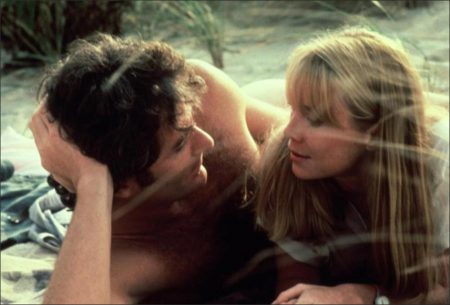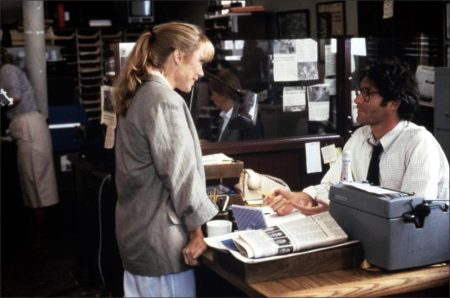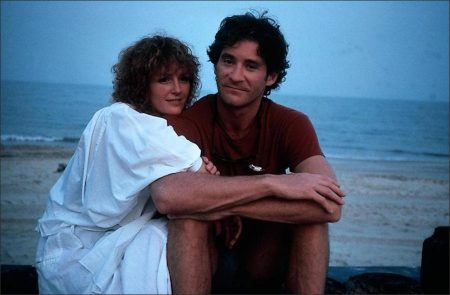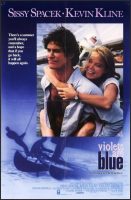Taglines: Nothing ever felt better.
Violets Are Blue movie storyline. Gussie Sawyer and Henry Squires are high school sweethearts in Ocean City, Maryland, during the 1960s. Her father runs a bumper car ride at the amusement park, and his dad is editor of the town newspaper. Both young people dream of adventure in a wider world. Gussie goes off to become an airline stewardess and then a famous photojournalist based in Paris. Her work appears in newspapers and magazines all over the world.
Henry leaves town to make a mark for himself in Boston but returns to Ocean city after his father’s death to run the paper; he settles into the family house with his wife Ruth and his son Addy. The greatest mark he makes on the world is through editorials against those who want to bring jobs at any cost to the community.
Now, for the first time in fifteen years, Gussie returns for a long-needed vacation with her parents. She and Henry meet, and after much uneasiness, resume their love affair. They also join forces to expose the nefarious activities of developers on an island adjacent to Ocean City. Gussie then offers Henry an opportunity to break into the big time by working with her on an overseas assignment about the children of war.
Violets Are Blue is a 1986 American romantic drama film directed by Jack Fisk and starring Sissy Spacek, Kevin Kline, Bonnie Bedelia, John Kellogg, Augusta Dabney, Kate McGregor-Stewart, Adrian Sparks, Annalee Jefferies, Mike Starr, Keith Sargis and Michael Mack. The film was released on April 25, 1986 and distributed by Columbia Pictures.
Film Review for Violets Are Blue
Two-thirds through “Violets Are Blue” (selected theaters), Sissy Spacek exclaims enthusiastically to Kevin Kline, “God, it would be a week in the Mideast and Central America!” You’d think she were talking about a Club Med vacation.
Ensuing unintended laughter makes the film, heretofore engaging, burst like a soap bubble. And like Humpty Dumpty after his fall, there’s no putting it together again. For all its heart-tugging, “Violets Are Blue” isn’t strong or original enough to sustain such a stumble.
Spacek plays a renowned news photographer, a contemporary Margaret Bourke-White, who has returned to her hometown, Ocean City, that lovely old Maryland resort, for her first real vacation in 13 years. Kline was once her sweetheart, and while both had dreamed of getting out and accomplishing big things, only Spacek made it. Early on, Kline unexpectedly became ensnared by responsibilities, inheriting the local paper from his father and marrying an already pregnant Bonnie Bedelia.
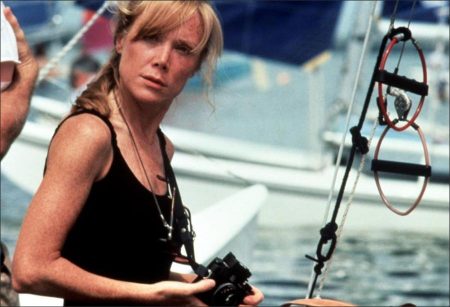
Yet, after so long a separation, the Paris-based Spacek and Kline discover that time has not lessened their attraction to each other. He represents the love and security she’s never found in her single-minded drive to get to the top; Spacek, in turn, triggers Kline’s frustrations, for she’s done all that he had wanted to do himself.
Cinematographer Ralf Bode captures the invitingly sunny, lazy resort atmosphere of Ocean City in summer–the charming old houses, the beauty and excitement of the boat races, the nostalgic fun of the amusement zone where Spacek’s father (John Kellogg) has run the bumper cars for 30 years. You have no trouble identifying with Spacek, burned out and eager to draw close to her loving family. And you have no trouble understanding the enduring spark between her and Kline, for they are both still young, attractive (and quite selfish).
But when “Violets Are Blue,” written by Naomi Foner from an idea conceived by debuting producer Marykay Powell, falls apart, we realize it’s been heading for trouble from the start. Since there’s little time to establish Spacek’s credentials as a celebrated photographer, we must take such claims on the basis of a rapid collage; but a glimpse of her photographing some little girls in Northern Ireland establishes her maternal yearnings, not her talent.
Unfortunately, the extravagance of these claims only makes her seem all the more unfeeling toward Bedelia and her son (Jim Standiford, as likable and believable an adolescent as you could wish). If Spacek had simply gone off to New York to pursue a more ordinary career she might have come across as more sympathetic. Since this isn’t the case, Spacek inadvertently sets up Bedelia to steal the picture.
Bedelia also benefits from some of Foner’s best writing, playing a gracious, pretty woman who knows herself and what she wants, a woman who loves quiet, small-town family life. In her understated way, she is thoroughly appealing. Also impressive is Kellogg, who has a well-written scene with Spacek that’s filled with fatherly plain talk.
A subplot involving Kline’s crusade to protect a natural habitat from condo builders might well have been developed to give the film greater dramatic impact. But it’s Kline’s problem, not Spacek’s, and “Violets Are Blue” is above all a star vehicle, albeit one that doesn’t allow Spacek to be as persuasive as usual. Currently garnering raves for his Off-Broadway Hamlet, Kline is as convincing as his generally unsympathetic leading-man role–not truly co-starring–permits.
As in “Raggedy Man,” Spacek’s director-husband Jack Fisk is capable with actors and is affectionately attuned to small-town America. He’s still better at getting full emotional value in intimate scenes rather than in controlling a film’s overall structure and pacing. Since “Violets Are Blue” (PG-13 for adult situations), despite some fine moments, doesn’t seem special or personal enough, it plays like a TV movie–an impression enhanced, unfortunately, by the triteness of Patrick Williams’ romantic score.
JViolets Are Blue (1986)
Directed by: Jack Fisk
Starring: Sissy Spacek, Kevin Kline, Bonnie Bedelia, John Kellogg, Augusta Dabney, Kate McGregor-Stewart, Adrian Sparks, Annalee Jefferies, Mike Starr, Keith Sargis, Michael Mack
Screenplay by: Naomi Foner
Production Design by: Peter Jamison, Bo Welch
Cinematography by: Ralf D. Bode
Film Editing by: Edward Warschilka
Costume Design by: Joe I. Tompkins
Set Decoration by: Jane Bogart
Art Direction by: Bo Welch
Music by: Patrick Williams
MPAA Rating: PG-13 (Parents are strongly cautioned; some material may be inappropriate for children under 13)
Distributed by: Columbia Pictures
Release Date: April 25, 1986
Views: 272
